Knedlíky are traditional Czech dumplings which use a dough similar to bread dough. They're boiled and sliced, and served with a variety of traditional Czech dishes. If you enjoy Czech food, make this authentic recipe!
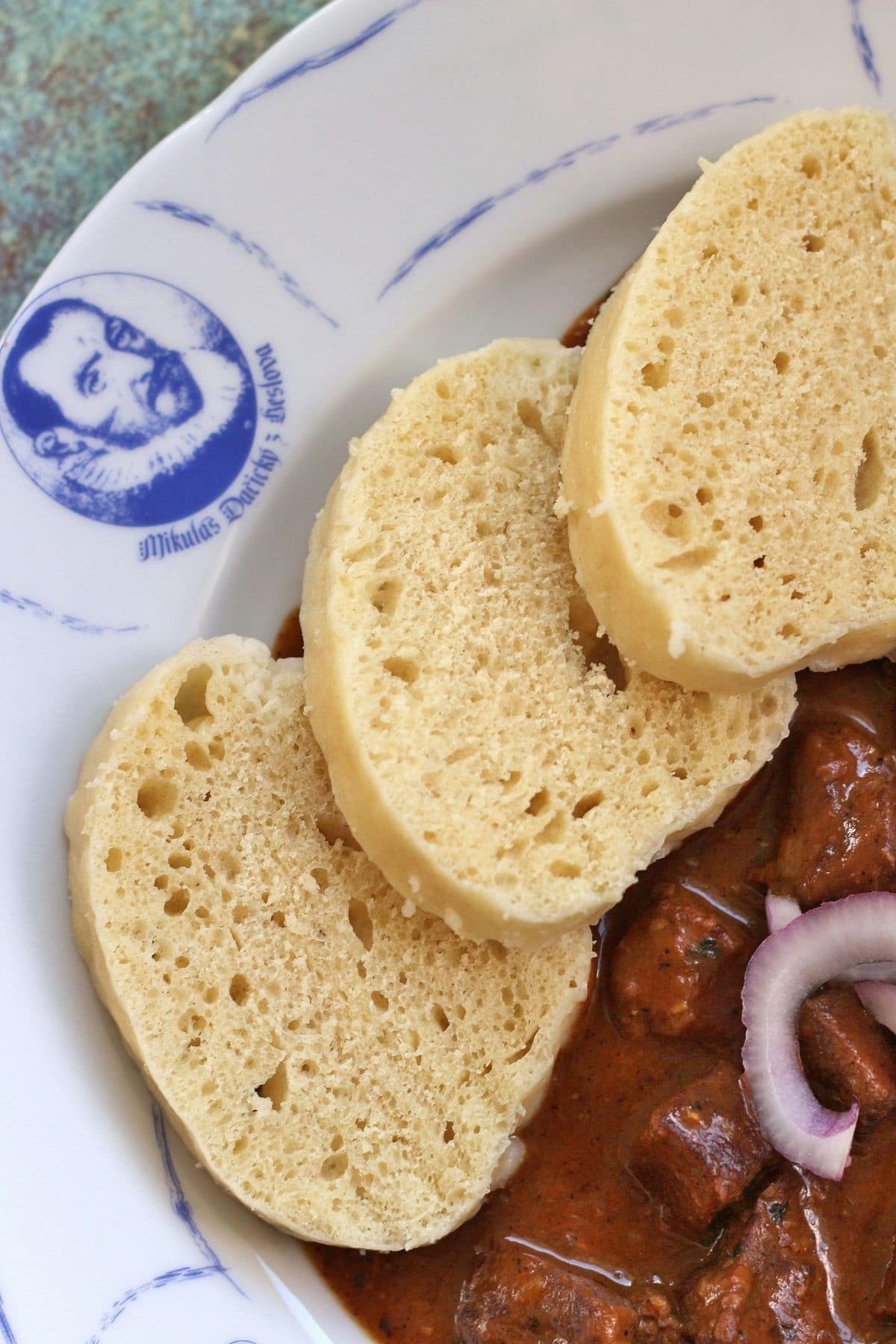
Czech cuisine is considerably humble, with influences from surrounding countries. Much of Czech cuisine consists of comforting recipes for soups, stews, and meat dishes (namely pork, beef, and poultry including game birds). Furthermore, Czech dumplings are a popular counterpart to many meals.
There are many different ways to make traditional Czech dumplings, or knedlíky.
One version is bread dumplings, or houskový knedlíky, which uses a combination of diced stale bread bound together with flour, milk, eggs, and leavening. It is sometimes also called knedlo, knödel, kniddel, and canederli depending on the country or culture of origin including the likes of Germany, Austria, Poland, Hungary and even Italy.
Another, bramborové knedlíky or potato dumplings, features mashed potatoes, eggs, flour, sometimes butter or other ingredients. Versions of these dumplings are also common is some of the surrounding countries.
You can also make Czech dumplings using a type of bread dough. This is the version of knedlíky we'll explore for this recipe.
Ingredient notes
This recipe for knedlíky uses a dough very similar to typical bread dough. It uses yeast for leavening and is enriched with milk. It uses a coarser instant or quick-mixing flour that is different from all-purpose or bread flour. The availability of this flour can range in different parts of the world, but here are some options for acceptable flours you can use for this recipe.
- United States: Wondra flour (by Gold Medal brand)
- Czech Republic: Hrubá mouka
- Canada: Robin Hood Easy Blend
- Australia: Continental flour (any brand)
- Germany: Aurora Instant Mehl Type 405 or any Spätzlemehl
Instant flour is a low-protein, finely ground wheat flour which has been pre-cooked and dried. You can use leftover instant or quick-mixing flour to thicken gravies and sauces. If you live in any other countries, try to find a type of flour with similar qualities, or see if you can order one of the above types of flour online. You cannot simply substitute all-purpose flour for the instant flour because the texture and consistency will not be the same.
These Czech dumplings use dry active yeast for the recipe. I have not tested it with different types of yeast, however I will provide general substitution guidelines in case you need to try them.
- Instant yeast: reduce the amount of yeast by 25% and mix the yeast directly into the flour mixture. Proceed with the recipe as directed.
- Fresh yeast: double the amount of yeast and crumble it into your warm milk mixture. Proceed with the recipe as directed.
Once again, these are only general guidelines for substituting yeast. I have not made this recipe with instant or fresh yeast, but am providing these steps just in case you need them.
This recipe uses kosher salt (aka cooking salt, kitchen salt, coarse salt outside of the US). If you are using table salt, you can scale down the salt as that is a saltier type of salt by volume! You will also be salting the water for cooking these dumplings so there is an opportunity to add more salt later when they cook.
How to make them
Begin by combining the warm milk, sugar, and yeast in a medium mixing bowl. Let it bloom for about 10 minutes. Beat the egg into the milk mixture.
Next, combine the flour and salt in a large mixing bowl, stir in the milk and egg mixture, and knead together for a few minutes until smooth. The dough can be a bit tacky but shouldn't be very sticky. If it's sticky, add a bit more flour as needed. Cover with a towel and let it rise in a warm spot for 2 hours or until doubled in size (PHOTOS 1-2).
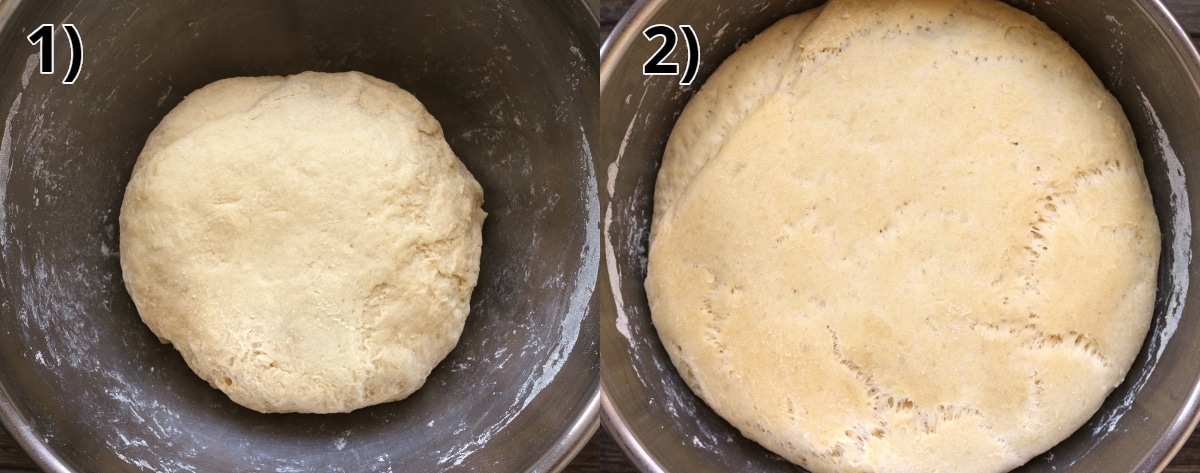
Cut the dough into thirds, and shape each piece of dough into a 2-inch thick rope. I like using a digital scale to divide my dough into equal sized pieces, but you can eyeball it if you don't have a scale. You may or may not need to flour your work surface depending on if you dough is a bit sticky or not.
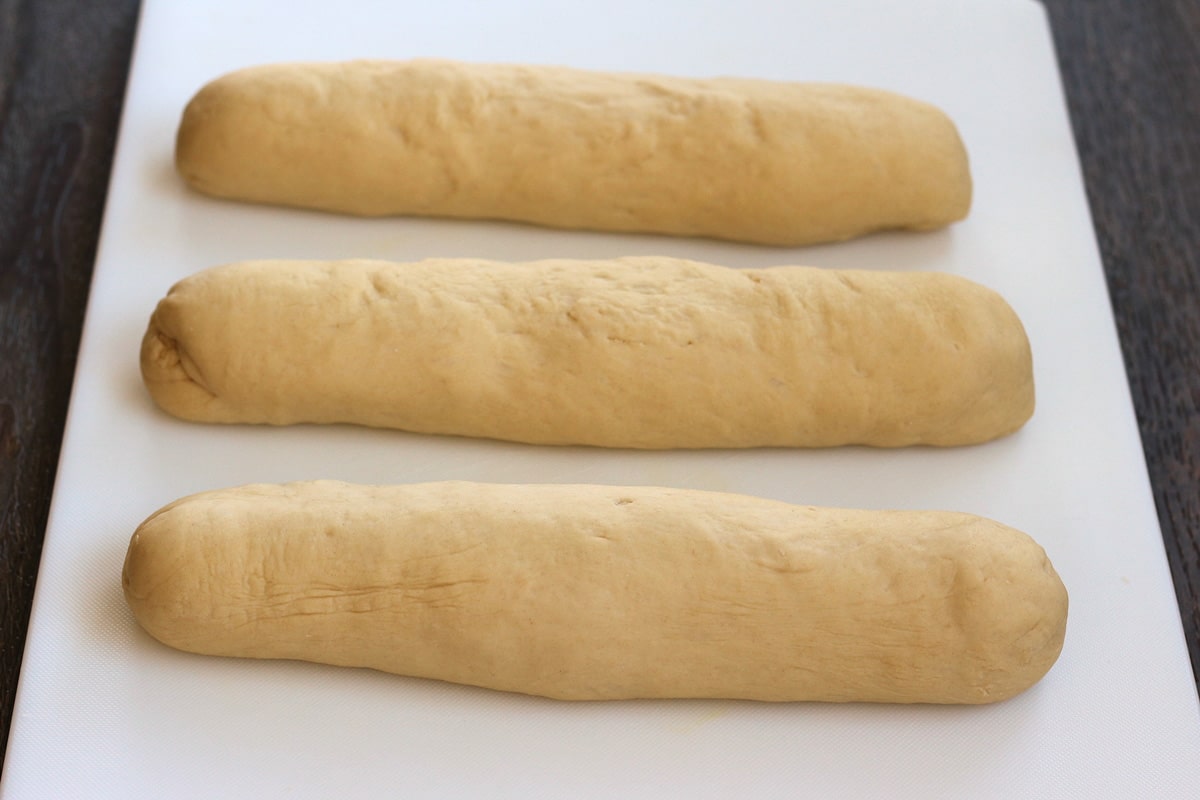
Cover with a towel, and let the shaped dumplings rise for 15 minutes. Meanwhile, select a pot that is at least 10-inches wide and deep enough to boil water. Add water and salt and bring to a boil. Boil the dumplings uncovered for 20 minutes flipping them over halfway through. The dumplings will expand quite a bit (PHOTOS 3-4).
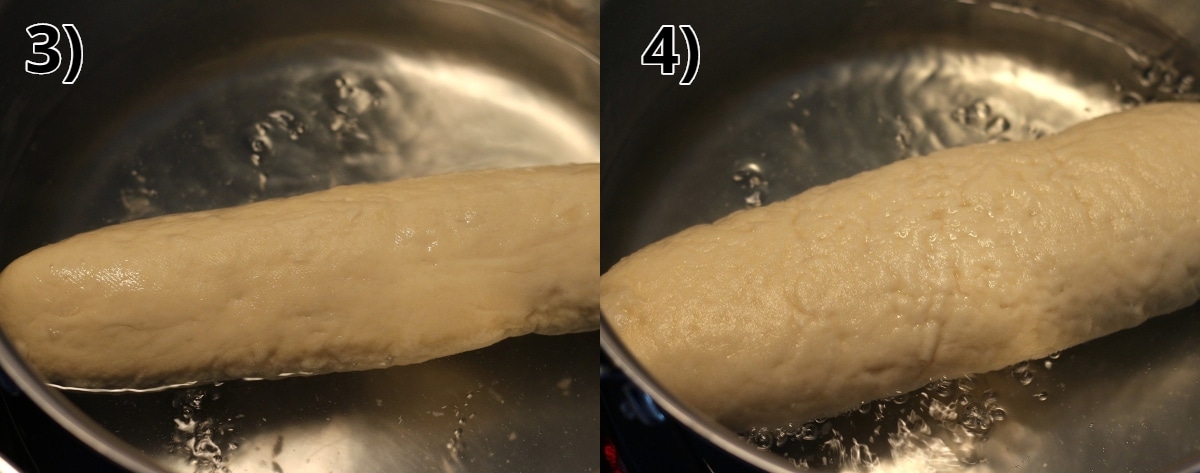
If they don’t all fit in your pan at once, cook them in batches. I cook mine one at a time, so it can be time consuming (a full hour to cook all 3 dumplings) but it's not very hands on. Set a timer for 10 minutes, then flip. Set your timer for another 10 minutes, then remove. Easy peasy.
After removing from the boiling water with a large slotted spoon or spatula, immediately poke them with a toothpick in a few spots to let the steam out. Cool for at least 5 minutes before slicing with a serrated knife, thread, or dental floss into about ¾-inch-thick slices.
I find that these dumplings are fine at room temperature for a while before serving them. Mine have sat out for an hour or longer before I served them with dinner. Cover them so they don't dry out if you aren't going to serve them immediately. You can also store them and heat them up again at a later time.
Please scroll to the bottom of the post for the full recipe (in a printable recipe card) including ingredient amounts and detailed instructions.
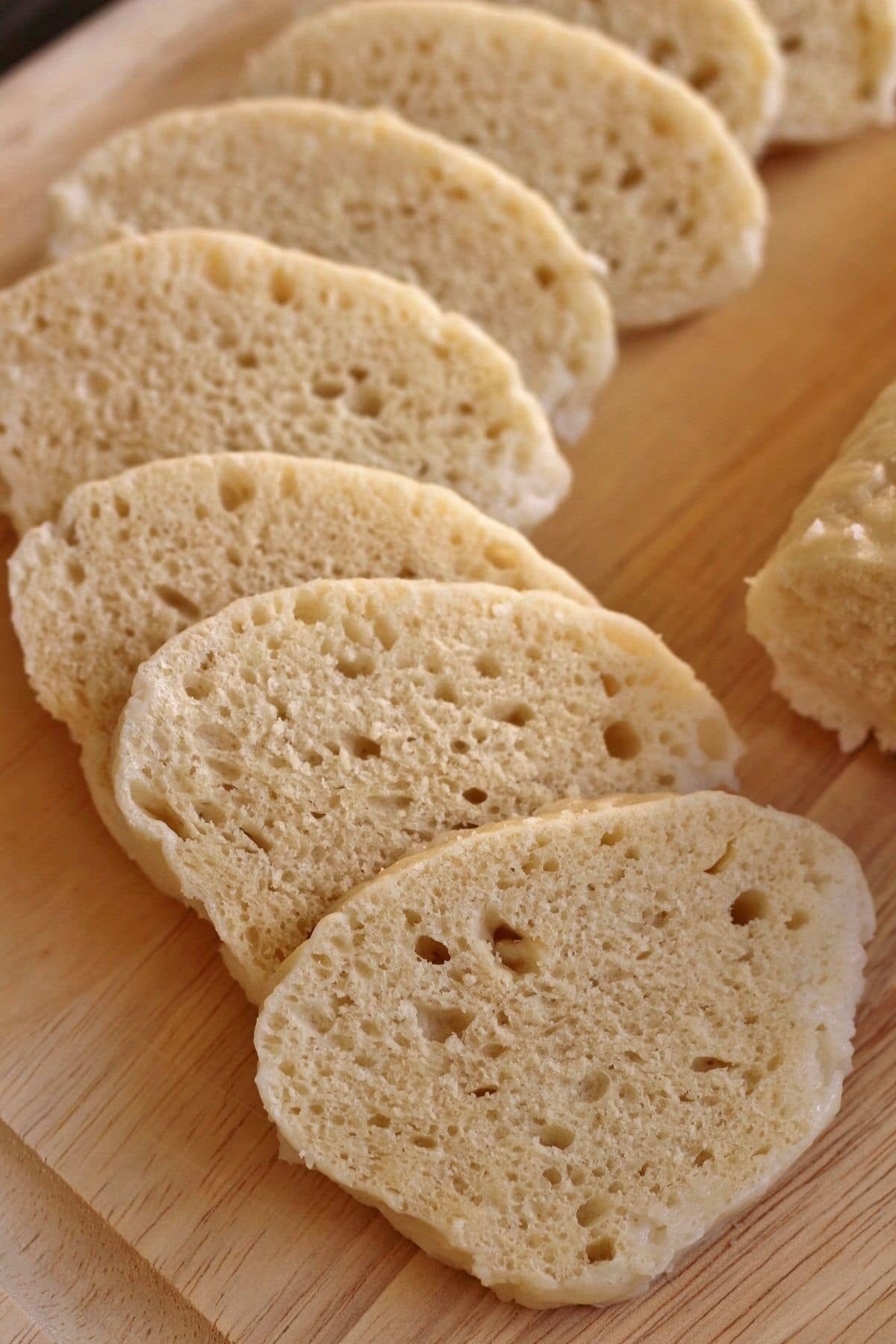
How to store and reheat them
Cool dumplings completely, wrap them in aluminum foil or plastic wrap, then place in freezer bags into the refrigerator or freezer. You can refrigerate dumplings for several days, or freeze them for longer (about 3 to 6 months since they are basically bread). You will definitely need to reheat/refresh the dumplings before serving.
If previously frozen, thaw dumplings completely (preferably overnight in the refrigerator) and slice them into portions.
Steaming is the best way to reheat your Czech dumplings. Add a little water to a pot and place a steamer basket over the top. Heat it on high heat, then once you hear the water boiling, lower the heat so it’s more of a gentle simmer. Arrange sliced dumplings on the perforated steamer, cover, and steam for 2 to 3 minutes until heated through.
As a backup option, you can also wrap the dumplings with a damp paper towel, put them on a plate and microwave for about 30 seconds until softened and heated through.
What to serve with these dumplings
Czech dumplings are soft and slightly chewy with a spongy quality that is great at soaking up sauces and gravies on your plate. Knedlíky are traditionally served with roasted meats like pork, goose, or duck, or saucy stews and roasts like Czech beef goulash (hovězí guláš) and Czech marinated roast beef with creamy vegetable sauce (svíčková).
Honestly, I just think of them as spongy bread and would use them as such. If it's got some delicious drippings or a luscious gravy, serve it with knedlíky!

Other Czech recipes you may like
- Česnečka (Czech Garlic Soup aka Hangover Soup)
- Hovězí Guláš (Czech Beef Goulash)
- Nakládaný Hermelín (Czech Marinated Cheese)
- Obložené Chlebíčky (Czech Open-Faced Sandwiches)
- Perníčky (Czech Gingerbread Cookies)
This recipe for Czech dumplings looks and tastes EXACTLY like the knedlíky I enjoyed on my trip to Prague and the Czech Republic. Definitely make this recipe if you've ever wanted to make authentic Czech dumplings!
Tried this recipe? Please leave a star ⭐️⭐️⭐️⭐️⭐️ rating in the recipe card below and/or a review in the comments section further down the page. You can also follow me on social media on Facebook, Instagram, and Pinterest!
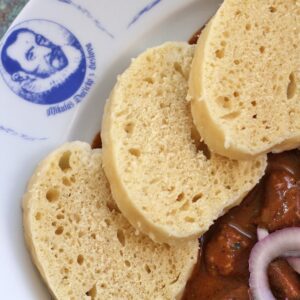
Knedlíky (Czech Dumplings)
Ingredients
- 1 ½ cups milk (warm to the touch)
- 1 teaspoon granulated sugar
- 1 teaspoon dry active yeast
- 1 large egg
- 4 ¾ cups (635 grams) quick-mixing or instant flour (such as Wondra flour; see notes for alternatives and tips on measuring)
- 1 ½ teaspoons kosher salt
Instructions
- Combine the warm milk, sugar, and yeast. Let it bloom for about 10 minutes. Beat the egg into the milk mixture. Combine the flour and salt in a large mixing bowl, stir in the milk and egg mixture, and knead together for a few minutes until smooth. The dough can be a bit tacky but shouldn't be sticky. If it's sticky, add a bit more flour as needed. Cover with a towel and let it rise in a warm spot for 2 hours or until doubled in size.
- Cut the dough into thirds, and shape each piece of dough into a 2-inch thick rope. Cover with a towel, and let the shaped dumplings rise for 15 minutes.
- Meanwhile, in a large pot (at least 10-inches wide), bring salted water to a boil. Boil the dumplings uncovered for 20 minutes flipping them over halfway through. They will expand quite a bit. If they don’t all fit in your pan at once, cook them in batches. Note that if you do need to cook them in batches, plan for 1 hour total cooking time.
- After removing from the boiling water with a large slotted spoon or spatula, immediately poke them with a toothpick in a few spots to let the steam out. Cool for at least 5 minutes before slicing with a serrated knife, thread, or dental floss into about ¾-inch-thick slices.
Notes
- Wondra flour is a type of quick mixing or instant flour by Gold Medal brand available in the United States. It is more coarse than regular all-purpose flour. Here are some alternatives for flours you can try for making these in other countries. These flours vary in weight and absorption so start with a bit less flour and add more as needed.
- Czech Republic: Hrubá mouka
- Canada: Robin Hood Easy Blend
- Australia: Continental flour (any brand)
- Germany: Aurora Instant Mehl Type 405 or any Spätzlemehl
- When in doubt, measuring by weight is always preferable to measuring by volume. The conversion of Wondra flour in this recipe from cups to grams is accurate (both by testing and also confirming the conversion on the Wondra packaging which states that ¼ cup = 30 grams). If you're measuring by volume and your dumplings turn out dry, you are packing too much flour into your cups. Spoon flour into the cup and level off the top for the best results, or better yet weigh it with a digital scale.
- This recipe uses dry active yeast. I have not tested this recipe with different types of yeast, however I will provide general substitution guidelines in case you need to try them.
- Instant yeast: reduce the amount of yeast by 25% and mix the yeast directly into the flour mixture. Proceed with the recipe as directed.
- Fresh yeast: double the amount of yeast and crumble it into your warm milk mixture. Proceed with the recipe as directed.
- To store: cool cooked dumplings completely, wrap them in aluminum foil or plastic wrap, then place in freezer bags into the refrigerator or freezer. You can refrigerate dumplings for several days, or freeze them for longer (about 3 to 6 months since they are basically bread). You will definitely need to reheat/refresh the dumplings before serving.
- To reheat: thaw dumplings completely (preferably overnight in the refrigerator) and slice them into portions. Add a little water to a pot and place a steamer basket over the top. Heat it on high heat, then once you hear the water boiling, lower the heat so it’s more of a gentle simmer. Arrange sliced dumplings on the perforated steamer, cover, and steam for 2 to 3 minutes until heated through. As a backup option, you can also wrap the dumplings with a damp paper towel, put them on a plate and microwave for about 30 seconds until softened and heated through.
Nutrition
*All nutritional information is based on third-party calculations and should be considered estimates. Actual nutritional content will vary with brands used, measuring methods, portion sizes and more.*

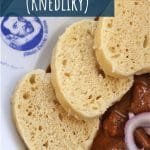
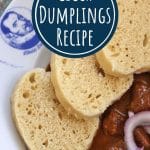
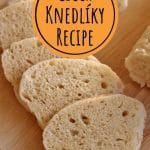
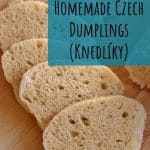
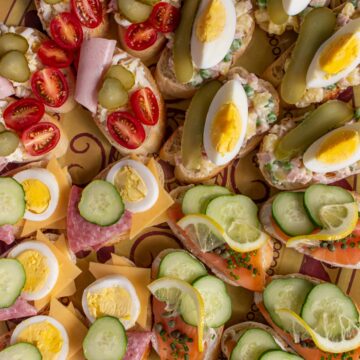
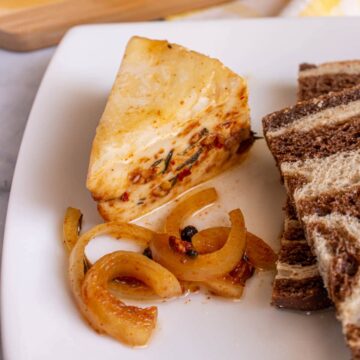
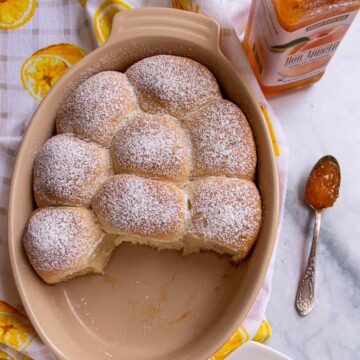

Oli says
Can’t find how much ingredients is required in Czech dumplings. Very confusing
Victoria says
Hi Oli,
If you were able to leave a comment, you scrolled right past the recipe card which contains the full recipe including all the ingredient measurements. You can always find the recipe card at the bottom of my posts, before reaching the comments section (this is the same with most food blogs). You can also click on the "Jump to Recipe" button at the very top of the post to skip down to the recipe card, but you will miss out on the other helpful information and step-by-step photos included in the post by doing that. Either way, it will get you right to the recipe with all of the ingredient measurements and instructions. I hope this helps.
Regina says
I made this bread to have with goulash. Followed the instructions and got the special blend flour from Robin Hood (Canada) it was just like what we had in Prague a couple of months ago. Thank you!
Nancy says
So good! Just like my Grandma made!
Sarah says
delicious result in Canada using Robin hood flour, and the active dry yeast...not exactly the same as in CZ but still really great, thanks for the tips!
Liz Walter says
Great recipe and easy to follow instructions. It’s great to have the photos to illustrate the various steps. Something that I’d like to point out though is about your comment about Kosher salt vs table salt. They are equally as salty-salt is salt. How they differ is that Kosher salt is less dense than table salt so if you weigh 1 tbsp Kosher salt (my preference is Diamond Crystal) it weighs 8 grams. The same amount of table salt weighs 18 grams. Compared gram to gram the sodium amount is equal it’s just that table salt because of the smaller crystals packs tighter together. A good rule of thumb is to halve the amount if someone uses table salt or give the measurements by weight not by volume although I realize that not everyone has or is comfortable using kitchen scales.
Victoria says
Hi Liz,
Yes, this is true about salt measurements, but it's not just table salt versus kosher salt. Even with kosher salt with different brands like Diamond Crystal vs Morton the size of the crystals is quite different and the volume measurements would range for the same weight as well. I use Diamond Crystal which has the larger crystals of the two (but it's also what many restaurants and professional chefs use) so my volume measurements are based on that. I have found that in the past there have been questions about salt so I find it's best to add a disclaimer just so people are aware and can adjust if needed 🙂 It's good to have that general knowledge so people can make adjustments as needed.
Liz Walter says
Thanks for your reply! I understand and agree with you absolutely (including the fact that Diamond Crystal is the best for cooking!) I live in Canada and it used to mean a trip to Niagara Falls to get some Diamond Crystal but it has gotten much better in the last 10 years or so. All the different types of salt and their best uses can be confusing sometimes. My heritage is Hungarian and like you mentioned in your article there is a lot of overlap in the Eastern European cuisines. I enjoyed looking at all your recipes. Thanks again.
Katie says
I grew up on a recipe just like this and it's my go to recipe for authentic Czech dumplings. My family had a resort for 80 years and grama made these all the time!
Sarita says
What kind of milk is used?
Victoria says
Hi Sarita,
You can use any kind of milk. I usually have 1% milk in my fridge and just use that without any issues.
Rodney L Manges says
How deep should the water be in the pan to boil them also how much salt added to water?
Victoria says
The depth of the water depends a bit on the pan, but I'd say about 3 inches or so would work well as long as your pan isn't too shallow where it would overflow when you add the dumplings. Salt it similarly to how you would salt pasta water. There isn't a measurement since the amount of water would vary from pan to pan. You can always taste the water to make sure you can taste the salt.
Dede says
When I take them out of the boiling water what do I put them on? Cookie sheet, paper towels?
Victoria says
I usually remove them to a cutting board, poke them with a toothpick, and let them rest on the board for a few minutes before I slice them on the board. You could certainly transfer them to a cookie sheet if that's easier and could blot them on a paper towel first too if you want to absorb some excess water. Either would work fine.
Home Cook SF says
Wondra flour only comes in 13.5 oz cannisters. Is it possible to use 00 flour or something that is possible to get in bulk?
Victoria says
I like the way you think! Unfortunately, Wondra flour is very different from something like 00 flour and I'm not sure you'd get the same results using a type of flour that isn't an "instant flour" such as Wondra. In other countries it's possible they sell this style of flour in bulk packaging, but in the U.S. I've only seen Wondra sold this way thus far. I had to purchase 2 containers of Wondra to make this recipe as well. I find that the remaining Wondra works great as a gravy thickener (which is how most people use it), so I manage to use up the extra that way.
Deb says
Wondra can get expensive! Where I live it’s over $4 per can and I would have needed three cans. I found a tip online that said you can mix 2 cups of flour with one teaspoon of cornstarch and then sift twice. I have a battery operated sifter so this was an easy task and it came out beautifully. And at a whole lot less $$ !
Victoria says
Thanks for sharing your tip! I'm glad it worked well 🙂
Rachael says
Can you also had dried bread cubes to the dumplings? If so, which bread is best to use?
Victoria says
Hi Rachael,
Yes, you could add small stale bread cubes to the dough to make Houskové knedlíky which are Czech bread dumplings. I'd say add about ¾-1 cup of small cubes of dry, stale white bread (more of a bakery style hearty bread rather than a soft sandwich style bread, which would just disintegrate). Fold them into the dough before proofing it.
Matthew says
If you only need to make one, can you freeze the other two prior to cooking the dough? And when ready to cook, thaw the dough and then boil for 20 minutes?
Victoria says
I would recommend cooking all the dumplings and then tightly wrapping and freezing any dumplings you don't plan to consume right away. They freeze really well after they are cooked, but I have never tried freezing them raw so I can't comment on how that would work.